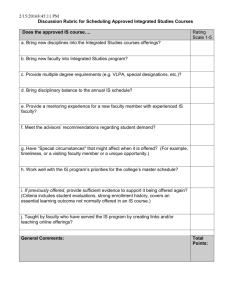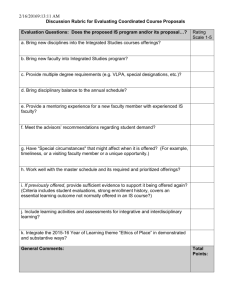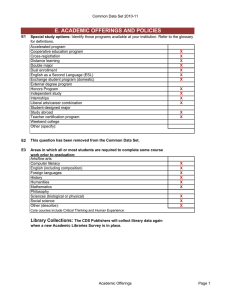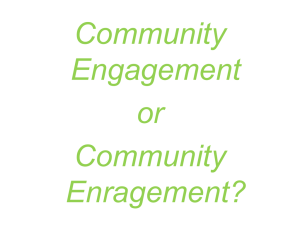Lesson 2. Experience Economy Strategies Adding Value to Rural Businesses
advertisement
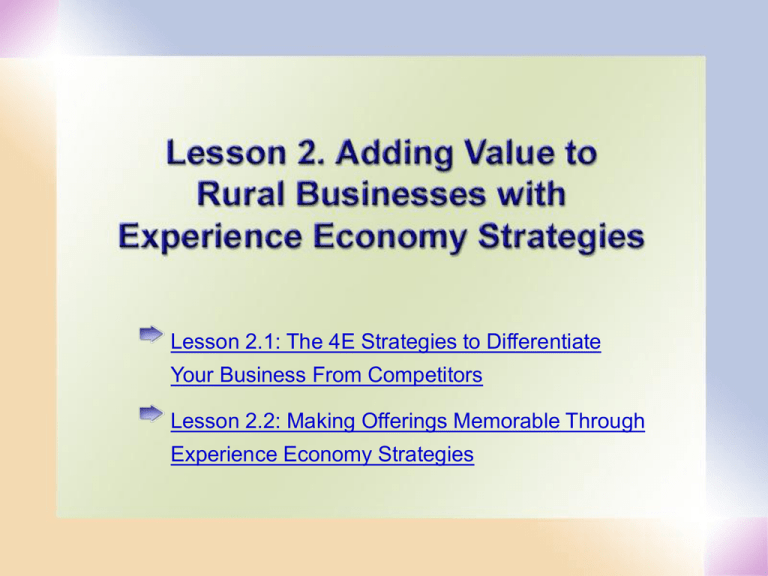
Lesson 2.1: The 4E Strategies to Differentiate Your Business From Competitors Lesson 2.2: Making Offerings Memorable Through Experience Economy Strategies 1 2 Competitive advantage is: • A distinct combination of offerings that customers want and only you can uniquely provide • What makes your business more attractive than your competition 3 How small businesses develop competitive advantages: • Traditional ways: – Delivering goods to customers better, cheaper, or faster • Non-traditional ways: – Enhancing customers’ experiences as a way of creating value for them 4 Experiences as a key competitive resource for small businesses because they: • Can be very unique • Are hard to copy • Are difficult for larger firms to effectively deliver on a personal customer level • Can be personalized and flexible 5 According to Pine & Gilmore, a “better” business means having: • Differentiated offerings from competitors, such as experiences • High quality goods and services Retail “Escapist” – Harry Potter party Pegasus & Pendragon Books: Berkeley, CA http://www.pegasusbookstore.c om/ 6 Experiential offerings can: • Address a higher level of customer value • Uniquely position and differentiate your small business • Create value for your business 7 A differentiation strategy must: • Offer a competitive advantage • Attract customers by positioning offerings in a unique and distinctive way • Be truly different in the eyes and mind of the customer • Be of value to the customer 8 Diagram for creating a unique combination of offerings to achieve differentiation Adapted from: Kotler, P. (1997). Marketing Management: Analysis, Planning, Implementation, and Control. Upper Saddle River, NJ: Prentice Hall. Pine, B.J., & Gilmore, J.H. (1999). The Experience Economy: Work is Theatre and Every Business a Stage. Boston, MA: Harvard Business School Press. 9 Using the diagram from Pine & Gilmore’s theater example: • Consider the following: – Goods are like props – Services can be seen as the stage – Personnel are the actors – Experiences are added to each element • All of the elements must work in coordination with each other for the “play” to be a hit 10 When considering your differentiation strategy, you must keep in mind: • All elements make sense and hinge on a common theme • How your customer experiences the theme • All of the details that support your theme taken into account 11 12 Making something memorable means to make a positive experience easy to recall or remember at will As a business owner, you should aim to make your business memorable 13 Experiences that may come to mind when you say, “I remember when….” • Situation of personal significance such as – Getting engaged – Winning an award • Rarity, surprise, or suspense such as – Spotting a mountain lion when on a neighborhood walk – An acrobatic circus show 14 Experiences that may come to mind when you say, “I remember when….” • Special design or sensory features such as – Decorations of a party or holiday – Incredible natural beauty of nature like the colors of a setting sun • Intensity of emotion such as – A really scary roller coaster ride – An exciting moment in sports 15 Memorable experiences lead to Word-of Mouth (WOM) advertising, which is: • Positive communication by the customer to friends and relatives • A cost effective promotional strategy • Often referred to as “free advertising” • Considered a more persuasive message when coming from a trusted source • Likely to reduce perceived risk associated with patronizing a new business 16 Creating memorable experiences requires the following specific techniques: • Repetition of information • Personally relevant experiences • Making sense of unexpected information • Physical performance of an action rather than simply observing • Multi-sensory (e.g., sight, smell, sound) experiences • Emotionally arousing experiences 17 Memory making techniques are embedded in Pine & Gilmore’s experience economy strategies by: • Creating a theme and harmonizing the cues around the theme reinforcing the business message • Offering educational and escapist experiences that actively engage the customer • Providing rich, multi-sensory settings • Arousing customers’ emotions 18
